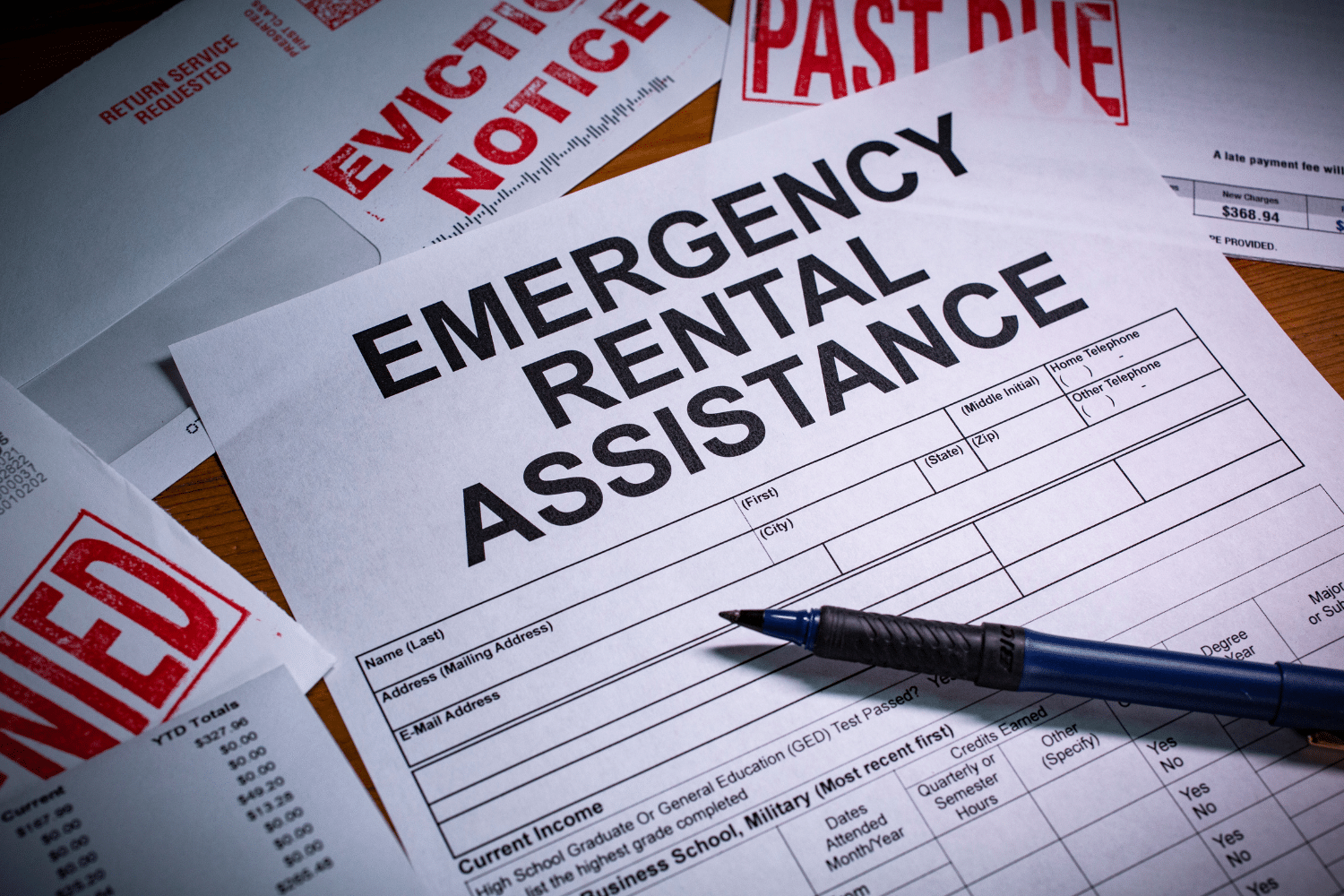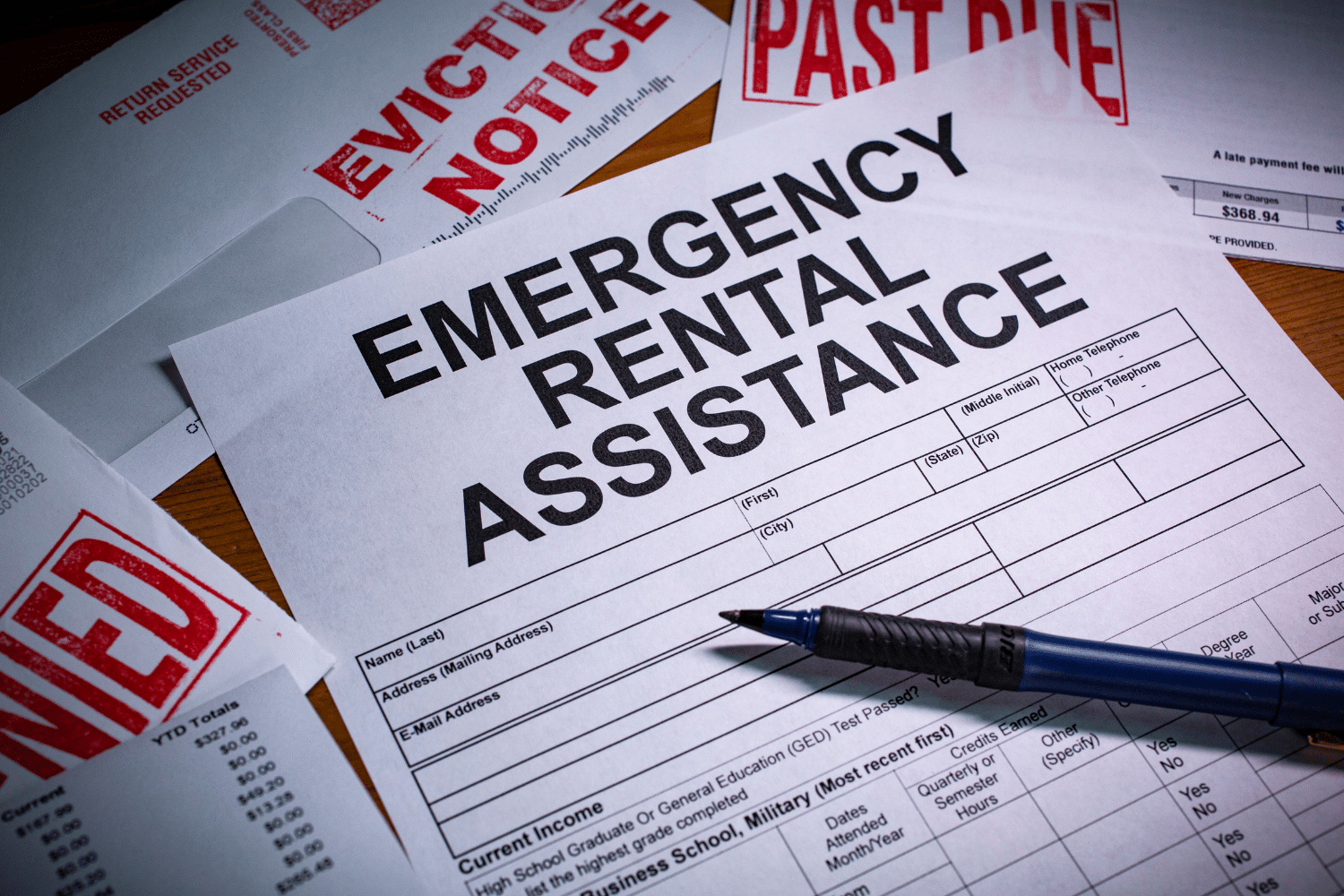If you’re facing the prospect of eviction or can’t make rent, emergency rental assistance may provide the support you need. This article dives into how you can qualify for these programs, what steps to take to apply, and where to find the help you need, laying the groundwork for you to secure financial aid and preserve your housing stability.
Key Takeaways
- The Emergency Rental Assistance Program (ERAP) helps households affected by COVID-19 with rent and utility payments. Eligibility requires household income at or below 80% of the area median income. Additionally, applicants must demonstrate a risk of homelessness or housing instability.
- Applicants must navigate varying local ERAPs, which have different eligibility criteria and application processes, necessitating an understanding of specific local requirements and deadlines to access funds effectively.
- ERAP offers financial aid to both renters and landlords, with programs providing funds to cover unpaid rent and utility costs to promote housing stability, and also includes additional support programs for unique households, such as those with disabilities or part of tribal communities.
Understanding Emergency Rental Assistance Programs

The Emergency Rental Assistance Program is a vital lifeline for households impacted by COVID-19. It helps them meet rent obligations and pay utility bills. These programs offer a range of support, including financial aid for unpaid rent and utility bills, ensuring that renters can maintain housing stability. To qualify, households must demonstrate a risk of homelessness or housing instability and typically have an income at or below 80% of the area median income.
Understanding the scope and purpose of ERAP is crucial. It not only covers rent and utility bills but also extends to other housing-related expenses, providing a comprehensive safety net for those in need. With funding sourced from significant legislative acts like the Consolidated Appropriations Act, 2021 (ERA1) and the American Rescue Plan Act of 2021 (ERA2), ERAP ensures that substantial resources are available to support eligible households.
What is the Emergency Rental Assistance Program?
The Emergency Rental Assistance Program (ERAP) stems from two major legislative acts: the Consolidated Appropriations Act, 2021 (ERA1) and the American Rescue Plan Act of 2021 (ERA2). ERA1 allocated an initial $25 billion, followed by an additional $21.55 billion under ERA2, reflecting the urgent need to support households affected by the pandemic. The primary goal of ERAP is to provide financial assistance and housing stability services to eligible households, ensuring they can weather the economic impacts of COVID-19.
ERAP funds cover a wide array of housing-related costs, including:
- Rent
- Rental arrears
- Utilities
- Home energy costs
- Other housing expenses
This comprehensive support system, provided by a property management company, is designed to prevent eviction and ensure that tenants can remain in their homes while managing their financial burdens.
Who Can Apply for ERAP?
Eligibility for the Emergency Rental Assistance Program hinges on several key criteria. Primarily, households must have a household income, in the form of an annual income, that does not exceed certain thresholds relative to the area’s median income. This ensures that the funds are directed towards those most in need, providing a financial cushion to the most vulnerable populations.
Additionally, applicants must demonstrate a risk of homelessness or housing instability, which can be evidenced through documentation such as eviction notices or proof of overdue rent. This dual requirement of income threshold and demonstrable risk ensures that ERAP assistance reaches those who are genuinely in need of support.
How to Apply for Rental Assistance
Applying for rental assistance through ERAP involves a structured process. Applicants need to provide documentation proving their income and housing instability. This may include pay stubs, tax filings, and eviction notices. Such documentation is crucial to verify eligibility and ensure that the assistance is directed appropriately.
Furthermore, applicants must complete an attestation confirming the accuracy of the information provided in their application. The application process is often managed through online portals, where applicants can submit required documents, check their application status, and update information as needed. This streamlined process helps in efficiently managing and processing the applications, ensuring timely support to those in need.
Navigating Local Emergency Rental Assistance Options

Local emergency rental assistance programs can vary significantly based on location, each with its specific eligibility criteria and application processes. These variations are crucial for applicants to understand, as they determine the type and extent of assistance available in different areas. For instance, in Maryland, the Department of Housing and Community Development administers federal emergency rental funding, while Arizona has its own set of criteria and processes.
Applicants need to:
- Identify their local rental assistance programs by selecting their county of residence
- Review specific program details available
- Navigate the application process more effectively, ensuring they meet all local requirements and deadlines.
This knowledge allows them to navigate the application process more effectively, ensuring they meet all local requirements and deadlines.
Finding Your Local Rental Assistance Program
Finding the right local rental assistance program starts with understanding the criteria set by local governments. For example, local governments must have a population of more than 200,000 residents to receive ERA funds, as per ERA1 and ERA2 guidelines. Residents in large cities like Phoenix can access programs like the Arizona Rental Assistance Program, which focuses on housing stability for low-income seniors and families with children.
In Maricopa County, the Housing Stability Rental Assistance program provides aid to renters facing financial hardships, coordinated by the Community Resilience Division for those outside primary cities. Understanding these local nuances is essential for applicants to successfully navigate and benefit from these programs.
Application Process for Local Programs
The application process for local programs may differ, but typically involves submitting required documentation and monitoring application status through online portals. For instance, the local program Arizona Department of Economic Security oversees the application process for the Arizona Rental Assistance Program, aligning it with the U.S. Department of the Treasury requirements.
Applicants should be aware of specific application period closures, such as the District of Columbia’s ERAP ending on July 1, 2024. Monitoring the application status can be done by logging into the official portal, or contacting helplines for assistance. These steps ensure that applicants stay informed and can address any issues promptly.
Financial Aid for Renters and Landlords

Financial aid under ERAP is not limited to renters alone; landlords also have opportunities to recover rental arrears, ensuring that both parties can navigate financial hardships. Programs like the Arizona Rental Assistance Program provide housing stability by offering lump-sum payments to cover rent arrears, future rent, and associated fees, up to a cap of $10,500.
This dual support system ensures that renters can stay in their homes while landlords can recover unpaid rent, promoting overall housing stability. Eligibility for these programs is based on income, needs, and household composition, making sure that assistance reaches those who need it most.
Support for Tenants Residing in Assisted Housing
Tenants residing in assisted housing can access additional support through programs like Section 811, which provides rental housing opportunities with supportive services for persons with disabilities. To be eligible for Section 811, households must be very low-income, and at least one adult member must have a qualifying disability.
The Section 811 program not only offers subsidized housing but also ensures access to supportive services, promoting independent living within the community. This comprehensive support is funded through various means, including capital advances and project rental assistance.
Opportunities for Landlords to Recover Rental Arrears
Landlords can recover unpaid rent through rental assistance programs by actively participating. They should request payment for rental arrears through programs like the Arizona Rental Assistance Program. Financial support ensures landlords aren’t disadvantaged by tenant arrears and can continue paying property rent.
If a landlord is unresponsive or fails to provide necessary information, ERAP funds are held temporarily. This facilitates resolution while safeguarding tenant rights. Therefore, landlords must be proactive and responsive to recover rental arrears.
Special Considerations for Unique Households
Unique households, such as tribal and Native Hawaiian communities or those with disabilities, have access to tailored ERAP support and accommodations. Overall, this recognition of diverse situations ensures that emergency rental assistance programs can adapt to various needs based on cultural, situational, or physical requirements.
Specific guidance and resources are provided for households on Hawaiian Home Lands. Those part of tribal governments, ensuring culturally sensitive support. Additionally, accommodations for households with disabilities guarantee equal access to emergency rental assistance, addressing challenges posed by the pandemic or limited technological access.
Tribal and Native Hawaiian Communities
Tribal housing authorities and Tribally Designated Housing Entities (TDHEs) administer various programs to create housing opportunities for Native families, with federal funding provided directly to the tribes or these designated entities. The programs include:
- Native American Housing Assistance and Self-Determination Act (NAHASDA)
- Indian Housing Block Grant (IHBG) program
- Indian Community Development Block Grant (ICDBG) program
The Native Hawaiian Housing Block Grant (NHHBG) program provides housing options, including rental assistance, to eligible Native Hawaiian families. The Department of Hawaiian Home Lands (DHHL) is its sole recipient.
Tribal members off Tribal lands and non-tribal members on Tribal lands may receive ERA1 funds from their tribe or TDHE. They must not receive assistance from another tribe, TDHE, state, or local government. Regulation amendments allow DHHL to provide tenant-based rental assistance. Also, this includes security deposits and first month’s rent for eligible families, on and off Hawaiian Home Lands, subject to appropriations acts.
Accommodations for Households with Disabilities
Accommodations ensure equal access to emergency rental assistance for households with disabilities. Grantees can offer waivers or exceptions to usual documentation requirements. These measures support applicants with disabilities. They also address challenges posed by the pandemic or limited technological access.
Keeping Track of Your ERAP Application
Keeping track of your ERAP application is crucial to ensure timely processing and receipt of funds. Submitting a complete application with all required documentation will expedite the review process and increase the chances of approval. Maintaining open lines of communication with the ERAP department can provide assistance and updates on the application process.
Applicants can receive updates on their application status through their preferred contact method, such as email or text, ensuring they stay informed on the progress. This proactive approach can help address any issues promptly and ensure that the application is processed without unnecessary delays.
Checking Your Application Status
Check your ERAP application status through designated portals, helplines, or by logging into your account. For example, Arizona Rental Assistance applicants can call a designated number or log in to monitor their status. Additionally, applicants receive notifications of missing documentation or updates through their chosen contact method. This ensures they stay informed.
For any queries or technical issues, ERA program recipients can contact the Arizona Rental Assistance program directly or utilize self-service resources provided by the Treasury. These resources ensure that applicants have all the necessary support to navigate the application process.
What to Do After Receiving ERAP Funds
After receiving ERAP funds, verify payments to landlords or utility providers. This ensures appropriate use of funds and necessary support for all parties.
Avoiding Missteps: Fraud Prevention and Reporting
Maintaining the integrity of the Emergency Rental Assistance Program is crucial to ensure that the assistance reaches those who genuinely need it. Honesty and accuracy during the application process are paramount, as fraudulent activity not only undermines the system but also diverts funds from eligible individuals.
If an applicant suspects fraudulent activity or misuse of funds, it is their responsibility to report it to:
- the appropriate state or local agency administering the assistance
- the Office of Inspector General of the relevant federal department
- state/local law enforcement
This vigilance helps maintain the program’s integrity and supports the equitable distribution of aid.
Recognizing and Preventing Fraudulent Activity
Recognizing and preventing fraudulent activity involves being vigilant about the accuracy of the information provided and being aware of common scam tactics. Here are some red flags for fraud:
- Local assistance programs will never ask for fees to expedite rental assistance applications
- Demands for payment, especially via cash, gift cards, or cryptocurrency
- Counterfeit websites with official-looking logos
By being aware of these red flags, you can protect yourself from scams.
Imposter scams also target applicants using emails and texts, falsely claiming to be from credible agencies or organizations and requesting sensitive information. Applicants must be vigilant to recognize these warning signs and avoid providing personal or financial information to unverified sources.
How to Report ERAP Fraud
If you suspect fraud in the Emergency Rental Assistance Program, report it to the local managing agency or the overseeing government entity. The Office of Inspector General encourages reporting ERA fraud to their office.
Additionally, in Arizona, report suspected ERAP fraud by calling 1 (833) 912-0878. Additionally, contact the Federal Trade Commission (FTC) for imposter scams related to rental assistance fraud. Local law enforcement can respond quickly and provide victim support services. They are crucial for reporting fraud.
Summary
In summary, the Emergency Rental Assistance Program offers a comprehensive support system for households affected by the COVID-19 pandemic. From understanding the program’s scope and eligibility criteria to navigating local options and preventing fraud, this guide equips you with the knowledge to secure the assistance you need. By staying informed and proactive, you can ensure housing stability and financial relief during these challenging times. Remember, hope and help are within reach—embrace the support offered by ERAP.
Frequently Asked Questions
Households with income below certain thresholds and at risk of homelessness or housing instability are eligible for the Emergency Rental Assistance Program. This is determined based on the area’s median income.
To apply for rental assistance, you’ll need to provide proof of income and housing instability, and complete an attestation confirming the accuracy of your information. Many applications are managed through online portals. Good luck with your application!
To find your local rental assistance program, you can select your county of residence and review the specific program details available. Local governments with a population over 200,000 residents can receive ERA funds.
To find your local rental assistance program, you can select your county of residence and review the specific program details available. Local governments with a population over 200,000 residents can receive ERA funds.
You can report suspected ERAP fraud to the local agency managing the rental assistance funds, the Office of Inspector General, the Federal Trade Commission, or local law enforcement. These organizations can assist in investigating and addressing cases of potential fraud.








